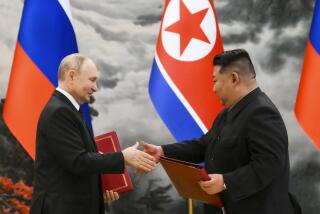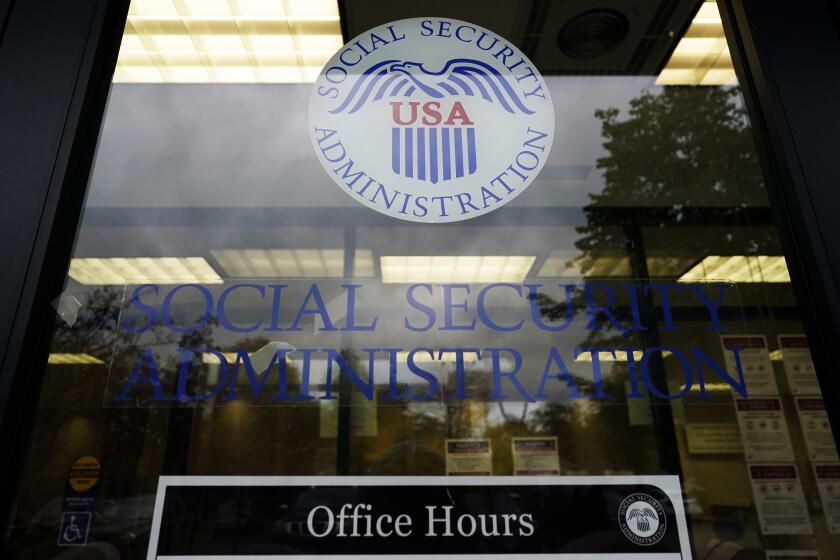Obama visits Korea’s DMZ
- Share via
Reporting from Seoul — The hard-to-predict and often-threatening plans of North Korea shadowed President Obama’s nuclear security summit as soon as he arrived in Seoul, injecting a Cold War note to a meeting designed to deal with newer threats of terrorism and the spread of nuclear materials.
The opening hours of the trip reprised similar journeys by his last two predecessors, reflecting the Korean peninsula’s status as one of the last vestiges of what used to be a worldwide divide.
Like Presidents George W. Bush and Bill Clinton, Obama traveled to the demilitarized zone that separates north and south, donning binoculars at a forward outpost only yards form the armistice line. The president gazed out over the stark, wooded mountains of North Korea, where the transition to a new regime has presented him with a new installment of a recurring puzzle.
All three presidents have tried to block, slow or roll back North Korea’s nuclear weapons program. North Korea’s arsenal, while small and crude by international standards, nonetheless poses a threat because of the regime’s history of sharing nuclear technology with others and of belligerence toward its southern neighbor, where tens of thousands of U.S. troops have been stationed for more than 60 years.
Administration officials had been cautiously optimistic just a few weeks ago about a deal with the North Koreans to provide food aid in return for an end to some parts of the nuclear program. But even before Obama arrived in Seoul, that agreement was in tatters, as North Korea appeared to be charging ahead with plans to launch a rocket over a chorus of objections.
North Korea claims it is launching a satellite to mark the 100th anniversary of the birth of Kim Il Sung, the founder of the regime and grandfather of the country’s new leader, Kim Jong Un, who took power after his father’s death in December. The United States says the launch would violate the deal, Japan has threatened to shoot down the rocket, and South Korean President Lee Myung-bak said the launch could result in further U.N. sanctions.
Making his first remarks about the launch, Obama seemed to cast North Korea as a willful child acting out for attention.
“Bad behavior will not be rewarded. There’s been a pattern for decades in which North Korea thought that if they acted provocatively, they would be bribed into ceasing and desisting,” Obama said at a news conference with Lee several hours after the visit to the DMZ.
“We’re going to break that habit,” he said.
Obama floated a possible cause for the rapid shift in North Korea’s position — from making an agreement to apparently scuttling it within weeks — suggesting that the young North Korean leader might not yet have consolidated power and that the new regime may be divided.
“The situation in North Korea is still very unsettled. It’s not clear exactly who is calling the shots and what their long-term objectives are,” Obama told reporters.
The president said he will attempt to enlist help from China, one of North Korea’s few allies, when he meets with Chinese President Hu Jintao on Monday. Explaining his message for Hu, Obama seemed to express some frustration with past failures of this approach, saying the Chinese had seemed to be “turning a blind eye” and “trying to paper over” North Korea’s provocations.
“That’s obviously not working,” Obama said.
Obama’s remarks came on the first day of the three-day set of diplomatic meetings around the summit. He also met with Turkish Prime Minister Recep Tayyip Erdogan to discuss the continued violence in Syria. The leaders declared themselves in agreement on the need for Syrian President Bashar Assad to step down and said they would use a meeting at the beginning of April to talk about ways to deliver non-lethal assistance to Assad’s opposition.
Deputy national security advisor Ben Rhodes, who described the meeting to reporters, said the aid would include communications tools and medicine.
Obama began his trip by making the 25-mile trek from Seoul to the DMZ, beyond the roadblocks, mine fields and barbed wire fencing to a windswept watch station 82 feet from the demarcation line. Obama looked out from behind bulletproof glass at the two small villages on either side of the line — Tae Sung Dong, the tiny South Korean town dubbed “Freedom Village,” and Gi Jong Dong, known to U.S. and South Korean officials as “Propaganda Village” for its fake buildings and speakers that once blared messages trying to lure soldiers to the north.
The messages no longer play, and Obama looked out in cold quiet as a North Korean flag flew over the village, lowered to mark the end of a 100-day mourning period for late leader Kim Jong Il.
“There’s something about this spot in particular,” Obama told a group of about 50 U.S. soldiers at Camp Bonifas, home to the U.N. joint security force that guards this section of the DMZ. “Where there’s such a clear line and there’s such an obvious impact that you have for the good each and every day that should make all of you proud.”
kathleen.hennessey@latimes.com
More to Read
Sign up for Essential California
The most important California stories and recommendations in your inbox every morning.
You may occasionally receive promotional content from the Los Angeles Times.











